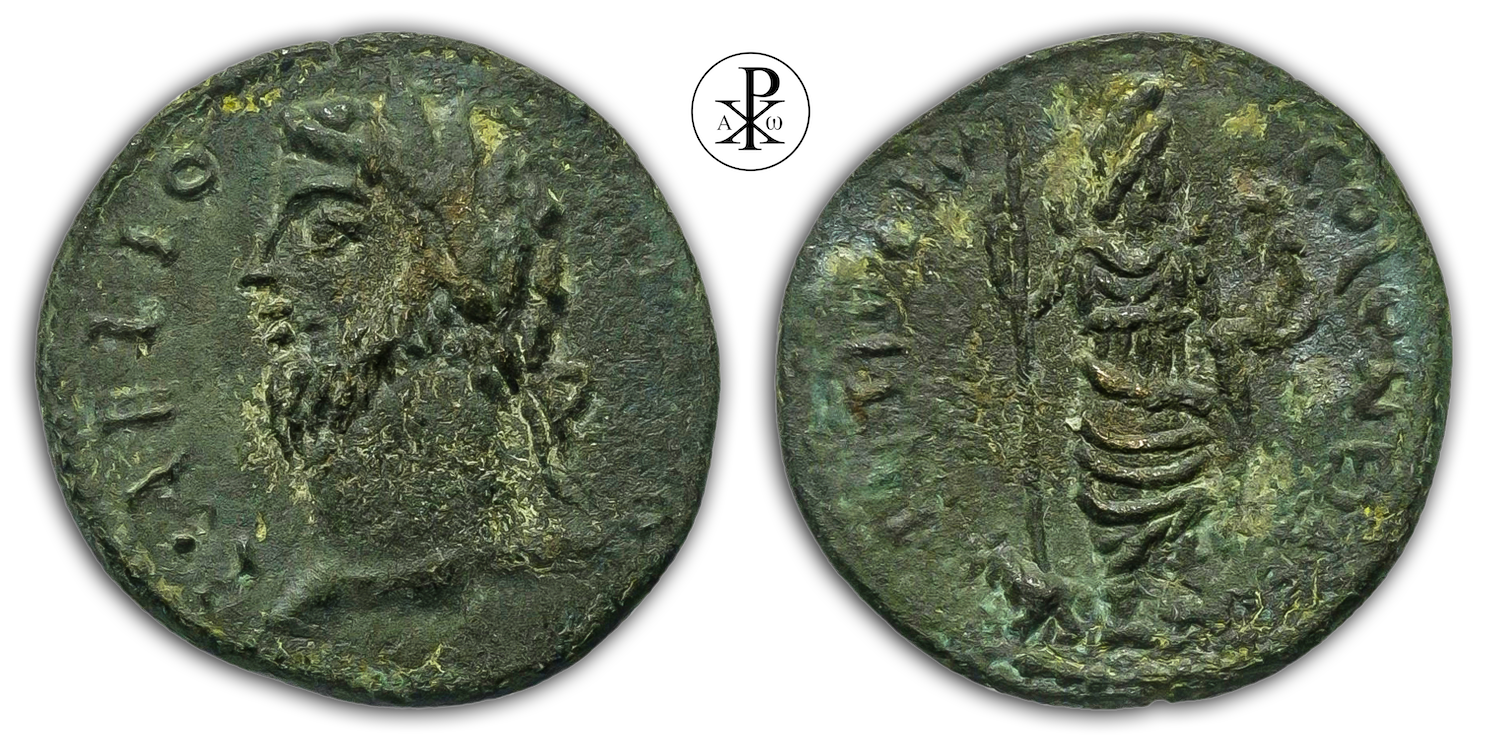Imperator Caesar Lucius Aelius Aurelius Commodus Augustus Pius Felix
Reign: Commodus
Mint: Antiochia ad Pisidiam, Pisidia
Date: 191/192 AD
Nominal: Bronze
Material: AE
Diameter: 22mm
Weight: 4.78g
Reference: RPC IV.3 25002 (this coin)
RPC Online: https://rpc.ashmus.ox.ac.uk/coins/4/25002
Rare: Specimens 1 (0 in the core collections)
Provenance: Solidus Numismatik Munich, Germany (Auction 116, Lot 131)
Pedigree: –
Special: Unpublished in the standard works, RPC Online Plate coin
Obverse: Laureate head of Commodus, left
Inscription: L AELIO C[OMMO]DO
Translation: Lucios Aelios Commodos
Translation: Lucius Aelius Commodus
Reverse: Mên standing with foot on bucranium, facing, head, right, wearing Phrygian cap, holding long sceptre and Victoria/Nike; behind his shoulders, crescent; to left, cock standing, left
Inscription: COLONEIAE ANTIOCHA
Translation: Colonia Antiochia
Comment: Antioch in Pisidia (Latin Antiochia ad Pisidiam, also Antiochia Caesarea or Colonia Caesarea) is an ancient city in Asia Minor in presentday Turkey. It is one of several cities founded by Seleucid rulers named Antiochos and named after them. As the boundaries of the Pisidian landscape were drawn differently over time, Antioch was at times not part of Pisidia. Pisidic Antioch was laid out with settlers from Magnesia on a strategic site near presentday Yalvaç. Following the insecurity problems generated by the Homanadensian wars and the death of Amyntas in 25 BC, Augustus commenced the establishment of colonies of legionary veterans in Asia Minor and, especially, in Pisidia. Those colonies provided room for the necessities of the growing veteran population resulting from the Late Republican civil wars and secured the new route called the via Sebaste that connected the Pamphylian coast with the centre of the peninsula. As shown by B. Levick, the site of Antioch played a key role at the end of a route that was also connected with the ancient ‘Royal road’ towards Lycaonia and Cilicia. The main bulk of colonists was detached from legio V Gallica and legio VII as attested by the epitaphs of veterans discovered near Yalvaç, and a series of coins in the reign of Vespasian recording their signa framing an eagle. The exact provenance of these veterans is disputed between Italy, southern France and even Hispania, but the onomastic evidence of Antioch since the foundation of the colony leaves no doubt about their western origin. Antioch in Pisidia quickly developed into one of the most important Roman cities in Asia Minor. As early as the 1st century AD, there is evidence of several senators who came from Antioch.
Men (Ancient Greek Mên, Latin Mensis) was an ancient lunar deity worshipped in Asia Minor, especially during the Roman Imperial period. The deity is possibly of Persian origin, as suggested by some elements common to the ancient Persian and Men religions. Earliest secure mentions date from the 4th/3rd century BC, but the majority of all evidence comes from the Roman imperial period. The deity was worshipped particularly in Asia Minor, especially in Lydia and Phrygia. Iconographically, she is distinguished by the crescent moon and the Phrygian cap. She wears sleeves and trousers, chiton and cloak. She appears both standing and riding, on horse, ram or cock, occasionally flanked by lions. Mên is attested in various localised variants, such as Mên Askaenos in Pisidia or Mên Pharnakou in Pontus. Taşlıalan (1988), in a study of Antioch in Pisidia, has noted that the people who settled on the Acropolis in the Greek colonial period carried the Mên Askaenos cult to the plain as „Patrios Theos“ and at the site where the Augusteum was built, some gives traces of this former cult as bucrania on the rock walls.
Autochthonous Mên as attested in Anatolia is to be distinguished from his reception as a „Phrygian god“ in Rome during the imperial period. Here, Mên is depicted with a Phrygian cap (like on this coin ) and a belted tunic. He may be accompanied by bulls and lions in religious artwork. The Roman iconography of Mên partly recalls that of Mithras, who also wears a Phrygian cap and is commonly depicted with a bull and symbols of the Sun and Moon. The Augustan History has the Roman emperor Caracalla venerate Lunus at Carrhae; this, i.e. a masculine variant of the feminine Latin noun luna „Moon“, has been taken as a Latinized name for Mên. The same source records the local opinion that anyone who believes the deity of the Moon to be feminine shall always be subject to women, whereas a man who believes that he is masculine will dominate his wife. David Magie suggests that Caracalla had actually visited the temple of Sin, the Mesopotamian Moon god.
This coin belongs to the extremely rare variations of the last Antiochia / Mên coinages. Commodus changed his name in 191 AD – recognisable here on the obverse with „L AELIO C[OMMO]DO“ – so that the issue of this bronze can be dated to 191/192 AD. The coin type presented here is unpublished in the standard citation works. There are two other coins known to me: from Agora Numismatics Auction 67 (lot 173) and Saint Paul Antiques Auction 2, lot 230. The bronze coin presented here was published by me at RPC.
